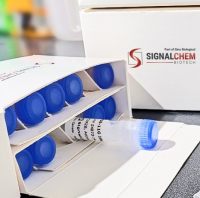Immobilization of Biomolecules onto Silica and Silica-Based Surfaces for Use in Planar Array Biosensors
互联网
681
Several methods are described in which a biological recognition molecule — a critical element in any biosensor — is immobilized onto a silica or silica-based sensing substrate. Although several variations are described, the methods for covalent immobilization share a common theme and are generally composed of three steps: modification of the surface to add specific functional groups (using appropriate silanes or an amine or carboxyl-containing hydrogel), covalent attachment of a crosslinker through one of its reactive moieties, and finally, covalent linking of the biomolecule (recognition element) to the remaining reactive moiety of the crosslinker. One final method is presented in which the surface is modified with a highly hydrophobic silane and a glycolipid recognition element immobilized, essentially irreversibly, by hydrophobic interactions. All of the methods described have been successfully used to immobilize biological recognition molecules onto sensing surfaces, with full functionality in biosensor-binding assays.









